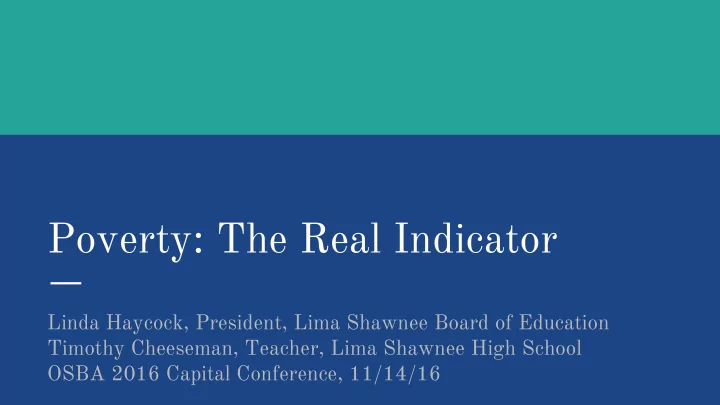

Poverty: The Real Indicator Linda Haycock, President, Lima Shawnee Board of Education Timothy Cheeseman, Teacher, Lima Shawnee High School OSBA 2016 Capital Conference, 11/14/16
Poverty
1. Poverty in Ohio 2. Poverty and Student Performance 3. School Solutions
Poverty, in the US and Ohio
The American Dream
“If you work hard, “Upward mobility is you have a chance the central promise to get ahead.” of life in America.” — Pres. Barack Obama — Speaker Paul Ryan
“Growing inequality and “...but America’s lack of upward engines of upward mobility...has jeopardized mobility aren’t middle-class America's working the way basic bargain.” they should.” — Pres. Barack Obama — Speaker Paul Ryan
Defining Poverty Absolute poverty: Relative poverty: Do you have money Do you fall below necessary to meet basic prevailing standards of needs, such as food, clothing, living in a given societal shelter, and community? context?
Poverty Rate By County, 2009-2013
Lima Shawnee School District
Lima Shawnee Poverty Levels (% of students qualifying for free or reduced lunch) 36% 21% 2005 2013
Poverty and Student Performance
“Grit” in Education ● Touted in professional development ● Meant to enhance students’ sustained effort and interest ● But socioeconomics can influence possession and application of “grit” ● Upper and lower classes don’t know each other very well ● We idolize miracle students
Poverty beyond Material Wellbeing ● Poverty isn’t just hunger, housing instability, lesser-quality possessions, etc. ● Poverty has social, political, and cultural manifestations
Poverty as a Root of Stress Housing instability: moves are seldom voluntary, often involve ● significant loss of material possessions and community networks Work: low wages, long and unpredictable hours, single wage, ● little chance for promotion, lack of childcare, lack of transit options Material disadvantage: lack of access to funds, food insecurity, ● unhealthy food options, poor quality clothing, no books/computer at home Safety concerns: bullying, neighborhood violence, domestic ● abuse, drug use
Harmful Non-Material Effects of Poverty Increased stress can negatively impact a child’s physical, psychological, emotional, and cognitive abilities. 1. Delayed brain development, reduced executive function, hopelessness, learned helplessness, depression 2. Emotional skills: Impatience and impulsivity, lack of social graces, more limited range of behavioral responses, less empathy for other’s misfortunes a. Feelings of pessimism, shame, isolation 3. Lack of exposure to broad vocabulary and formal language registers 4. Impaired parenting: less-developed skills, less time with children 5. Safety concerns lead to increased absenteeism, lack of engagement 6. Lack of support network outside of family & sometimes judgment for success
They’re Fıltered What happens to kids with these problems?
Think about a Job Interview ● Computer knowledge/access Dress clothing ● Experience with books ● Social graces ● ○ Some of which are explicitly taught! Knowledge of job interview ● questions ● Resume assembly Previous job experience ● Networks/references ●
What we focus on in education: ● Quality Teachers ● Child Nutrition New Facilities Extracurriculars ● ● Assessments Spectrum of Course Offerings ● ● Digital Delivery Transportation ● ● ● Curriculum ● Counseling and support Career Preparation Assessment Development, ● ● administration, and evaluation But poverty can limit gains from these efforts.
Possible Solutions
School Actions “Wrap-around” approach: health dept at school, navigator, etc. ● Incentivize/normalize academic success ● ● High quality teachers as student partners/mentors Incorporate coping skills and stress management techniques into curricula ● Identify and address roots of student misbehavior, including chronic stress ● Alter the environment: e.g., music to instead of bells for transitions ● ● Incorporating time for homework into the school day Incorporate physical activity into the daily routine. ● Goal setting instruction to help students focus on what they want ● Parenting classes ● ● School/community partnerships
Shawnee Opportunity School ● Created in 2016 to provide on-site digital delivery of curriculum for students at risk of dropping out/not graduating ● Includes full time enrollment (partial day on site) and school day enrollment for credit recovery 45 students actively enrolled ● ● 50% socio-economically disadvantaged
● Schools are in defensive mode trying to validate their performance. ● Performance indicators are important, but poverty is the most accurate indicator of student success. ● We should redirect some energy focused on schools to addressing the real indicator: poverty.
Poverty: The Real Indicator Linda Haycock, President, Lima Shawnee Board of Education Timothy Cheeseman, Teacher, Lima Shawnee High School OSBA 2016 Capital Conference, 11/14/16
Recommend
More recommend